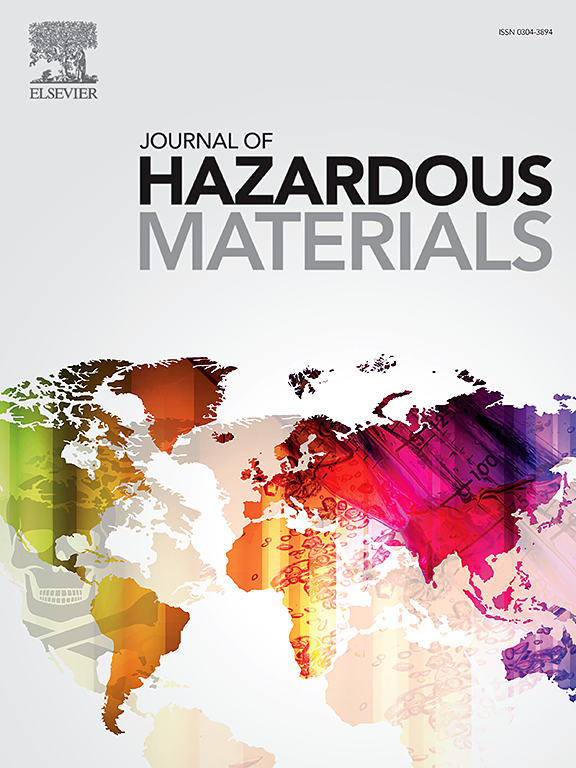Elucidation of the Arecoline Catabolism by Arthrobacter sp. Strain NyZ413
IF 12.2
1区 环境科学与生态学
Q1 ENGINEERING, ENVIRONMENTAL
引用次数: 0
Abstract
Arecoline, the main active ingredient in the widely consumed addictive substance areca nut, is known for its genotoxicity and cytotoxicity. It would be helpful to know whether environmental microbes can degrade the toxic arecoline. Here, an arecoline degrader Arthrobacter sp. strain NyZ413 was isolated and characterized from areca palm soil, utilizing arecoline as its sole carbon source for growth. Strain NyZ413 exhibited a robust growth even at high 20 mM arecoline, and optimally degraded 1 mM arecoline at 30°C. High performance liquid chromatography and liquid chromatography-mass spectrometry analyses indicated that acecainide and guvacine were intermediates derived from arecoline degradation by strain NyZ413. Degradation of arecoline and arecaidine by strain NyZ413 was shown to be inducible, whereas guvacine degradation was constitutive. The genome of strain NyZ413 consists of a 4.4 Mbp chromosome and a 246 Kbp mega-plasmid. Genomic and transcriptomic analyses proposed that the gene cluster A involved in arecoline degradation was located on the mega-plasmid. In addition, detoxification experiments showed that biodegradation by strain NyZ413 completely eliminated the embryotoxic effects of arecoline on zebrafish, confirming its high biosafety and potential for bioremediation in arecoline-contaminated environments. This study fills the gap in our understanding of microbial degradation of arecoline and also provides a bacterial resource for bioremediation of arecoline-polluted sites.

关节菌NyZ413对槟榔碱分解代谢的研究
槟榔碱是一种广泛食用的成瘾性物质槟榔果的主要活性成分,具有遗传毒性和细胞毒性。了解环境微生物是否能降解有毒的槟榔碱,将有助于研究。本研究从槟榔棕榈土壤中分离出一株槟榔碱降解菌节菌属(Arthrobacter sp.) NyZ413,利用槟榔碱作为其生长的唯一碳源。菌株NyZ413即使在高20 mM槟榔碱条件下也表现出强劲的生长,并在30°C下对1 mM槟榔碱进行了最佳降解。高效液相色谱和液相色谱-质谱分析表明,阿卡因胺和guvacine是由菌株NyZ413降解槟油碱产生的中间体。NyZ413菌株对槟榔碱和槟榔碱的降解是诱导性的,而对guvacine的降解是组成性的。菌株NyZ413的基因组由一条4.4 Mbp的染色体和一个246 Kbp的大质粒组成。基因组学和转录组学分析表明,参与槟油碱降解的基因簇A位于大质粒上。此外,解毒实验表明,菌株NyZ413的生物降解完全消除了槟榔碱对斑马鱼的胚胎毒性作用,证实了其高生物安全性和在槟榔碱污染环境中的生物修复潜力。该研究填补了我们对槟榔碱微生物降解的认识空白,也为槟榔碱污染场地的生物修复提供了细菌资源。
本文章由计算机程序翻译,如有差异,请以英文原文为准。
求助全文
约1分钟内获得全文
求助全文
来源期刊

Journal of Hazardous Materials
工程技术-工程:环境
CiteScore
25.40
自引率
5.90%
发文量
3059
审稿时长
58 days
期刊介绍:
The Journal of Hazardous Materials serves as a global platform for promoting cutting-edge research in the field of Environmental Science and Engineering. Our publication features a wide range of articles, including full-length research papers, review articles, and perspectives, with the aim of enhancing our understanding of the dangers and risks associated with various materials concerning public health and the environment. It is important to note that the term "environmental contaminants" refers specifically to substances that pose hazardous effects through contamination, while excluding those that do not have such impacts on the environment or human health. Moreover, we emphasize the distinction between wastes and hazardous materials in order to provide further clarity on the scope of the journal. We have a keen interest in exploring specific compounds and microbial agents that have adverse effects on the environment.
 求助内容:
求助内容: 应助结果提醒方式:
应助结果提醒方式:


